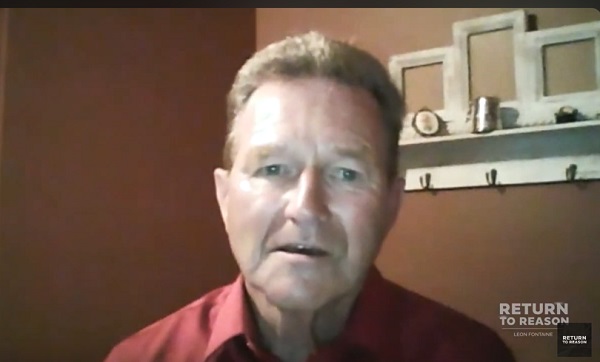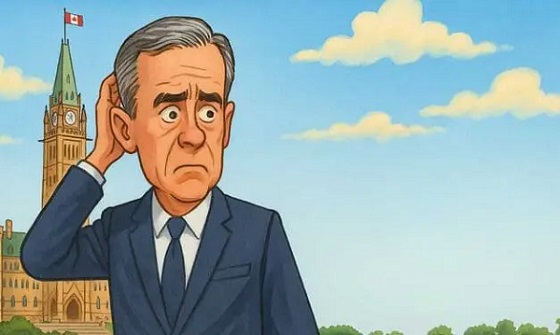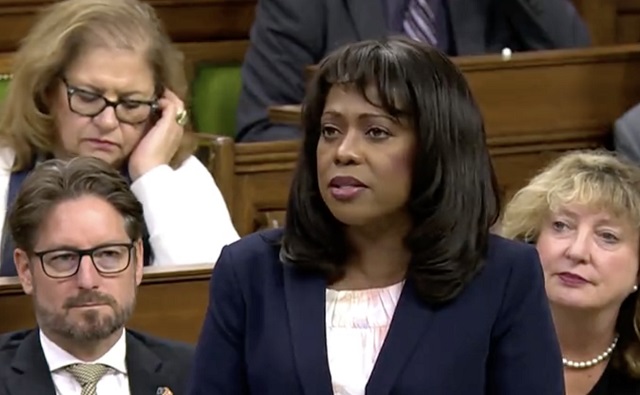National
Retired judge slams Trudeau gov’t for promoting ‘false’ accusation about residential school deaths

Retired Manitoba judge Brian Giesbrecht
From LifeSiteNews
Retired Manitoba judge Brian Giesbrecht observed that allegations were made with ‘no real evidence’ and that reports ‘that thousands of indigenous children had died at residential schools under suspicious circumstances’ are patently ‘false.’
A retired Canadian judge blasted what he said is a “conspiracy theory” lie and “shocking” yet unproven “accusation” being pushed by the Liberal federal government of Prime Minister Justin Trudeau and legacy media that thousands of Indigenous residential school kids died due to negligence by the Catholic priests and nuns.
“The Truth and Reconciliation Commission (TRC) accused Canadian priests, nuns, teachers, and staff at residential schools of somehow being responsible for the disappearance of thousands of indigenous children who attended the schools. That is a shocking accusation,” retired Manitoba judge Brian Giesbrecht wrote in a commentary piece published in the Western Standard last week.
“But it is even more shocking that the accusation was made with no real evidence to support it.”
Giesbrecht observed that reports from TRC commissioners that “that thousands of indigenous children had died at residential schools under suspicious circumstances” are patently “false.”
“Those allegations were false, and based on a conspiracy theory,” Giesbrecht said.
The judge lamented the fact that hundreds of Christian (mostly Catholic) churches have been burned to the ground since the first TRC report came out in 2010, with more than 100 being reduced to ashes since 2021.
In 2021 and 2022, the mainstream media and federal government ran with inflammatory and dubious claims that hundreds of children were buried and disregarded by Catholic priests and nuns who ran some of the schools.
The Tk’emlups te Secwepemc First Nation was more or less the reason there was a large international outcry in 2021 when it claimed it had found 215 “unmarked graves” of kids at the Kamloops Residential School. The claims of remains, however, were not backed by physical evidence but were rather disturbances in the soil picked up by ground-penetrating radar.
The First Nation now has changed its claim of 215 graves to 200 “potential burials.”
Giesbrecht wrote that the fires “increased significantly after the May 27, 2021, Kamloops announcement ramped up that claim to an actual accusation by the Tk’emlups Indian band that 215 children had died under sinister circumstances and were buried by priests in secrecy on the school grounds.
“Where did that Tk’emlups story come from? Most importantly, why would anyone believe such obvious nonsense?” he wrote.
According to Giesbrecht, the “conspiracy theory that launched the entire missing children claim” came from a “largely created” claim by defrocked United Church minister Kevin Annett.
“For reasons that defy rational explanation this unusual man made it his life’s work to take the alcoholic ramblings of a few Vancouvers east side street residents, polish them up, and present them as fact to the world,” the retired justice wrote.
Giesbrecht gave an example of how Annett repeated the story that “Queen Elizabeth had kidnapped 10 children from the Kamloops school, and those children were never seen again,” but was later exposed by an investigative reporter.
According to Giesbrecht, Annett “repeated stories about priests clubbing students to death and throwing them into graves dug by other students, dead boys hanging on meat hooks in barns, and babies thrown into furnaces by priests and nuns.”
“Respected investigative reporter Terry Glavin exposed Annett as a crank and debunked Annett’s wild stories in detail in a 2008 Tyee article. Annett’s stories are so obviously fake that it seems incredible that anyone believed them,” he said.
Giesbrecht noted that it is “hard” to believe that anyone thought the defrocked pastor’s tales were true, but the truth is, people “did” fall for it.
“In fact, some of the people who fell for these stories occupied important positions. One was Gary Merasty, a Member of Parliament. Merasty became so convinced that these claims, as presented in Kevin Annett’s most famous documentary, ‘Unrepentant’ were true, that he was able to convince the Assembly of First Nations (AFN) and other important politicians that the newly appointed TRC commissioners must investigate Annett’s claims,” he said.
According to Giesbrecht, the newly appointed TRC commissioners had “unwisely accepted this new area of study, despite the fact that they had no mandate to do so.”
“When the federal government refused their request for a mandate and funds to search for these phantom ‘missing children’ they ignored the rebuff, and pursued the subject anyway,” he wrote.
“It appears from their statements on the subject that they completely bought into the Annett conspiracy theory. Commissioner Murray Sinclair gave many interviews about these supposedly “missing children” and hinted frequently that dark forces were at play.
LifeSiteNews reported last week that Leah Gazan, backbencher MP from the New Democratic Party, brought forth a new bill that seeks to criminalize the denial of the unproven claim that the residential school system once operating in Canada was a “genocide.”
Media and Trudeau feds worked together to create unproven claims, says judge
Giesbrecht observed that the mainstream media, meanwhile, did not “question any of these always improbable claims,” and “quite the contrary, they not only played along with these baseless claims, but actively encouraged them.”
“It did not seem to occur to them that they were actively supporting a conspiracy theory,” he noted.
The retired judge noted that “Trudeau and his ministers,” notably Marc Miller, “made matters immeasurably worse by immediately ordering all federal flags to be flown at half mast and promising enormous amounts of money to any other indigenous community that wanted to make a similar claim.”
“The truth is that the TRC’s missing children wild goose chase had thoroughly captivated journalists and entire indigenous communities to the extent that the baseless Tk’emlups claim seemed to make sense to them. Justin Trudeau and his ministers were in that gaggle of gullibles. Canada became the laughing stock of the world for dumbly accepting these wild claims,” he wrote.
Giesbrecht observed how since the unfounded claims exploded on the Canadian media and political scene, both the “Trudeau government” and the state-funded “CBC have doubled down on their refusal to correct the misinformation that they have promoted.”
He warned that the next “logical step” for the Trudeau Liberals and mainstream media “is to stop Canadians from even knowing about” the truth of residential schools, as well as for those who have been muzzled or speaking out.
LifeSiteNews reported in August that Trudeau’s cabinet said it will expand a multimillion-dollar fund geared toward documenting claims that hundreds of young children died and were clandestinely buried at now-closed residential schools, some of them run by the Catholic Church.
Canadian indigenous residential schools, run by the Catholic Church and other Christian churches, were set up by the federal government and were open from the late 19th century until 1996.
While there were indeed some Catholics who committed serious abuses against native children, the unproved “mass graves” narrative has led to widespread anti-Catholic sentiment since 2021.
Conservative Party of Canada (CPC) MP Jamil Jivani has urged support from his political opponents for a bill that would give stiffer penalties to arsonists caught burning churches down, saying the recent rash of destruction is a “very serious issue” that is a direct “attack” on families as well as “religious freedom in Canada.”
Energy
A look inside the ‘floatel’ housing B.C.’s LNG workforce

From Resource Works
Innovative housing solution minimizes community impact while supporting the massive labour force needed for the Woodfibre LNG project.
The Woodfibre LNG project — a national leader in Indigenous partnerships and a cornerstone of global energy security — relies on a large construction workforce that drives economic prosperity across the region. For many of these workers, “home” is a ship.
Refitted from a cruise liner into a dedicated accommodation vessel, or “floatel,” this innovative solution houses up to 600 workers near Squamish, B.C., while keeping pressure off local housing and minimizing the project’s community footprint.
These exclusive images, captured a year ago, offer a rare retrospective look inside the original floatel. MV Isabelle X. With a second accommodation ship, the MV Saga X, recently arrived, this photo essay gives a timely, ground-level view of life aboard: individual cabins, a full-service dining hall, recreation spaces and custom laundry facilities. It’s a glimpse into the offshore dormitory that anchors daily life for the crew bringing this vital energy project to completion.

An arcade room is seen on a “floatel” that Woodfibre LNG plans to use to house 600 construction workers at a liquefied natural gas export facility being built near Squamish, during a media tour in Vancouver, on Thursday, May 9, 2024. The ship arrived in B.C. waters in January after a 40-day journey from Estonia, where it had sheltered Ukrainian refugees, but the District of Squamish council voted three to four against a one-year permit for its use last week.

A dining area is seen on a “floatel” that Woodfibre LNG plans to use to house 600 construction workers at a liquefied natural gas export facility being built near Squamish, during a media tour in Vancouver, on Thursday, May 9, 2024. The ship arrived in B.C. waters in January after a 40-day journey from Estonia, where it had sheltered Ukrainian refugees, but the District of Squamish council voted three to four against a one-year permit for its use last week.

A cabin is seen on a “floatel” that Woodfibre LNG plans to use to house 600 construction workers at a liquefied natural gas export facility being built near Squamish, during a media tour in Vancouver, on Thursday, May 9, 2024. The ship arrived in B.C. waters in January after a 40-day journey from Estonia, where it had sheltered Ukrainian refugees, but the District of Squamish council voted three to four against a one-year permit for its use last week.

Bridgemans Services Group president Brian Grange stands at the stern on a renovated cruise ship known as a “floatel” that Woodfibre LNG plans to use to house 600 construction workers at a liquefied natural gas export facility being built near Squamish, during a media tour in Vancouver, on Thursday, May 9, 2024. The ship arrived in B.C. waters in January after a 40-day journey from Estonia, where it had sheltered Ukrainian refugees, but the District of Squamish council voted three to four against a one-year permit for its use last week.

A custom built heat pump unit that allows the ship to avoid using diesel while docked and at anchor is seen on a “floatel” that Woodfibre LNG plans to use to house 600 construction workers at a liquefied natural gas export facility being built near Squamish, during a media tour in Vancouver, on Thursday, May 9, 2024. The ship arrived in B.C. waters in January after a 40-day journey from Estonia, where it had sheltered Ukrainian refugees, but the District of Squamish council voted three to four against a one-year permit for its use last week.

The main entry and exit area for workers is seen on a “floatel” that Woodfibre LNG plans to use to house 600 construction workers at a liquefied natural gas export facility being built near Squamish, during a media tour in Vancouver, on Thursday, May 9, 2024. The ship arrived in B.C. waters in January after a 40-day journey from Estonia, where it had sheltered Ukrainian refugees, but the District of Squamish council voted three to four against a one-year permit for its use last week.

A renovated cruise ship known as a “floatel” that Woodfibre LNG plans to use to house 600 construction workers at a liquefied natural gas export facility being built near Squamish, is seen at anchor in the harbour in Vancouver, on Thursday, May 9, 2024. The ship arrived in B.C. waters in January after a 40-day journey from Estonia, where it had sheltered Ukrainian refugees, but the District of Squamish council voted three to four against a one-year permit for its use last week.

A tugboat and water taxi are seen docked at a renovated cruise ship known as a “floatel” that Woodfibre LNG plans to use to house 600 construction workers at a liquefied natural gas export facility being built near Squamish, at anchor in the harbour in Vancouver, on Thursday, May 9, 2024. The ship arrived in B.C. waters in January after a 40-day journey from Estonia, where it had sheltered Ukrainian refugees, but the District of Squamish council voted three to four against a one-year permit for its use last week.
All photos credited to THE CANADIAN PRESS/Darryl Dyck
Resource Works News
National
Alberta will use provincial laws to stop Canadian gov’t from trying to confiscate legal firearms

From LifeSiteNews
Premier Danielle Smith confirmed that her government will introduce a motion to protect lawful gun owners from improper seizures and prosecution.
Alberta Premier Danielle Smith confirmed what she has promised for over a year now that her government will use its laws to stop Liberal Prime Minister Mark Carney’s federal gun-grab of legally purchased firearms from taking effect in the province.
“I just announced that our government will introduce a motion under the Alberta Sovereignty within a United Canada Act next week,” she posted on X over the weekend.
“This motion will protect lawful gun owners from improper seizures and prosecution, and ensure Albertans can protect their homes, families, and property.”
Smith’s motion was officially revealed on Tuesday. It reads, “A new motion under the Alberta Sovereignty within a United Canada Act will, if passed by the legislature, instruct all provincial entities, including law-enforcement agencies such as municipal police services and the RCMP, to decline to enforce or implement the federal gun seizure program.”
“The motion also makes clear that Albertans have the right to use reasonable force to defend themselves, their families and their homes from intruders,” it notes.
Smith has many times before, as reported by LifeSiteNews, promised her province will refuse to participate in his planned gun buyback program that aims to seize the legally purchased guns of Canadian firearm owners.
Alberta’s “Sovereignty Act” allows it to ignore federal laws that the province views as being unconstitutional.
Smith’s United Conservative Party (UCP) recently held its AGM, at which a motion to support so-called “Castle Laws” was introduced and passed.
She was recently quoted as saying, “If you don’t want to get shot, don’t break into someone’s house.”
Smith has promised that her government will introduce a so-called “Castle Law” to protect the rights of homeowners.
Violent crime against homeowners is on the rise in Canada. As reported by LifeSiteNews, Conservative leader Pierre Poilievre lashed out at Carney’s “catch and release” bail laws, saying they need to be rescinded while adding Canadians have a “right” to defend their homes. He made the comments after a 46-year-old father died defending his family home.
The Canadian government’s controversial gun grab Bill C-21, which bans many types of guns, including handguns, and mandates a buyback program became law on December 14, 2023, after senators voted 60- 24 in favor of the bill.
In May 2023, Bill C-21 passed in the House of Commons. After initially denying that the bill would impact hunters, former Prime Minister Justin Trudeau eventually admitted that C-21 would indeed ban certain types of hunting rifles.
Trudeau’s gun grab was first announced after a deadly mass shooting in Nova Scotia in May 2020 in which he banned over 1,500 “military-style assault firearms” with a plan to begin buying them back from owners.
Late last year, the Trudeau government extended the amnesty deadline for legal gun owners until October 30, 2025. It should be noted that this is around the same time a federal election was to take place.
When it comes to gun-related deaths in Canada, as reported by LifeSiteNews, Statistics Canada data shows that most violent gun crimes in the country last year were not committed at the hands of legal gun owners but by those who obtained the weapons illegally.
-

 MAiD2 days ago
MAiD2 days agoFrom Exception to Routine. Why Canada’s State-Assisted Suicide Regime Demands a Human-Rights Review
-

 Business2 days ago
Business2 days agoCarney government should privatize airports—then open airline industry to competition
-

 Alberta2 days ago
Alberta2 days agoCarney’s pipeline deal hits a wall in B.C.
-

 Alberta1 day ago
Alberta1 day agoAlberta Sports Hall of Fame Announces Class of 2026 Inductees
-

 Censorship Industrial Complex1 day ago
Censorship Industrial Complex1 day agoConservative MP Leslyn Lewis slams Liberal plan targeting religious exemption in hate speech bil
-

 Business2 days ago
Business2 days agoWhat’s Going On With Global Affairs Canada and Their $392 Million Spending Trip to Brazil?
-

 Business2 days ago
Business2 days agoIs Carney Falling Into The Same Fiscal Traps As Trudeau?
-

 Energy1 day ago
Energy1 day agoCanada following Europe’s stumble by ignoring energy reality






